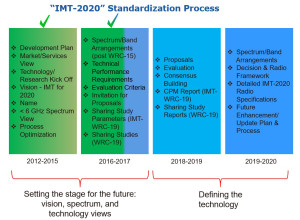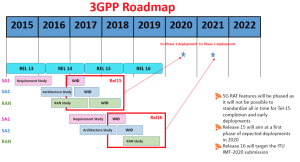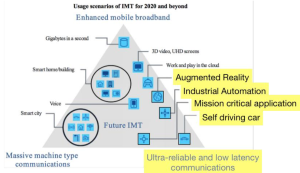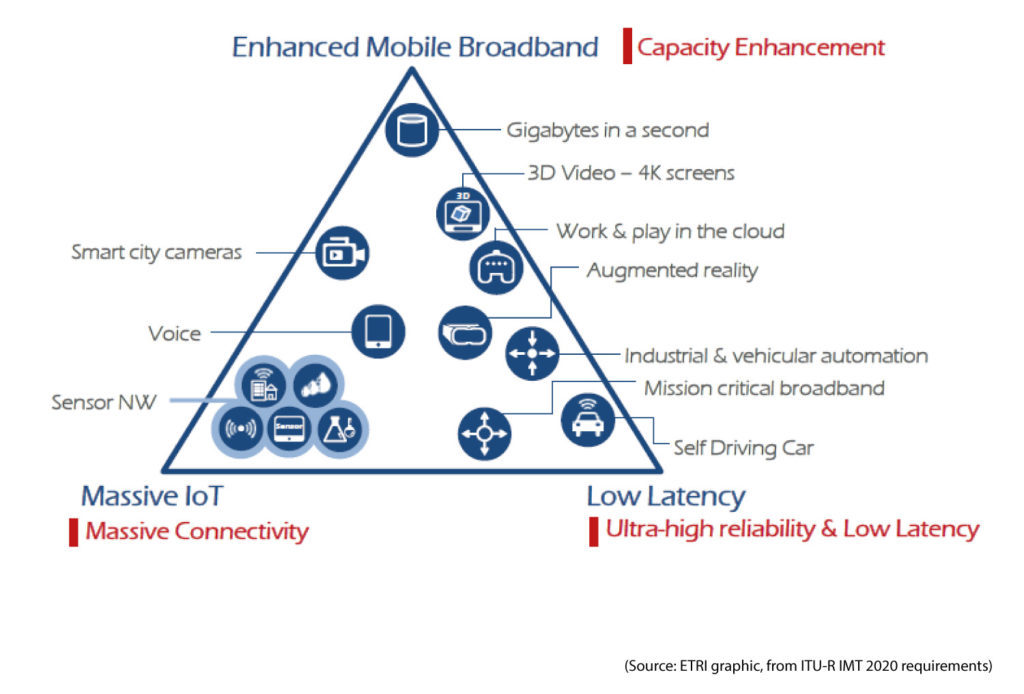Peter Lobner
In my 20 April 2016 post, “5G is Coming, Slowly,” I discussed the evolution of mobile communications technology and the prospects for the deployment of the next generation: 5G. The complexity of 5G service relative to current generation 4G (LTE) service is daunting because of rapidly increasing technical demands that greatly exceed LTE core capabilities. Examples of technical drivers for 5G include the population explosion in the Internet of Things (IoT), the near-term deployment of operational self-driving cars, and the rise of virtual and augmented reality mobile applications.
Progress toward 5G is steadily being made. Here’s a status update.
1. International Telecommunications Union (ITU) technical performance requirements
The ITU is responsible for international standardization of mobile communications technologies. On 23 February 2017, the ITU released a draft report containing their current consensus definition of the minimum technical performance requirements for 5G wireless (IMT-2020) radio service.
The ITU authors note:
“….the capabilities of IMT-2020 are identified, which aim to make IMT-2020 more flexible, reliable and secure than previous IMT when providing diverse services in the intended three usage scenarios, including enhanced mobile broadband (eMBB), ultra-reliable and low-latency communications (URLLC), and massive machine type communications (mMTC).”
This ITU’s draft technical performance requirements report is a preliminary document that is a product of the second stage of the ITU’s standardization process for 5G wireless deployment, which is illustrated below:

Source: ITU
The draft technical performance requirements report provides technical definitions and performance specifications in each of the following categories:
- Peak data rate
- Peak spectral efficiency (bits per hertz of spectrum)
- User experience data rate
- 5th percentile user spectral efficiency
- Average spectral efficiency
- Area traffic capacity
- Latency
- Connection density
- Energy efficiency
- Reliability
- Mobility
- Mobility interruption time
- Bandwidth
You’ll find a good overview of the ITU’s draft performance requirements in an article by Sebastian Anthony entitled, “5G Specs Announced: “20 Gbps download, 1 ms latency, 1M device per square km,” at the following link:
https://arstechnica.com/information-technology/2017/02/5g-imt-2020-specs/?utm_source=howtogeek&utm_medium=email&utm_campaign=newsletter
You can download the ITU’s draft report, entitled “DRAFT NEW REPORT ITU-R [IMT-2020 TECH PERF REQ] – Minimum requirements related to technical performance for IMT-2020 radio interface(s),” at the following link:
https://www.itu.int/md/R15-SG05-C-0040/en
In the ITU standardization process diagram, above, you can see that their final standardization documents will not be available until 2019 – 2020.
2. Industry 5G activities
Meanwhile, the wireless telecommunications industry isn’t waiting for the ITU to finalize IMT-2020 before developing and testing 5G technologies and making initial 5G deployments.
3rd Generation Partnership Project (3GPP)
In February 2017, the organization 5G Americas summarized the work by 3GPP as follows:
“As the name implies the IMT-2020 process is targeted to define requirements, accept technology proposals, evaluate the proposals and certify those that meet the IMT-2020 requirements, all by the 2020 timeframe. This however, requires that 3GPP start now on discussing technologies and system architectures that will be needed to meet the IMT-2020 requirements. 3GPP has done just that by defining a two phased 5G work program starting with study items in Rel-14 followed by two releases of normative specs spanning Rel-15 and Rel-16 with the goal being that Rel-16 includes everything needed to meet IMT-2020 requirements and that it will be completed in time for submission to the IMT-2020 process for certification.”
The 2016 3GPP timeline for development of technologies and system architectures for 5G is shown below.

Source: 3GPP / 5G Americas White Paper
Details are presented in the 3GPP / 5G Americas white paper, “Wireless Technology Evolution Towards 5G: 3GPP Releases 13 to Release 15 and Beyond,” which you can download at the following link:
http://www.5gamericas.org/files/6814/8718/2308/3GPP_Rel_13_15_Final_to_Upload_2.14.17_AB.pdf
Additional details are in a February 2017 3GPP presentation, “Status and Progress on Mobile Critical Communications Standards,” which you can download here:
http://www.3gpp.org/ftp/Information/presentations/Presentations_2017/CCE-2017-3GPP-06.pdf
In this presentation, you’ll find the following diagram that illustrates the many functional components that will be part of 5G service. The “Future IMT” in the pyramid below is the ITU’s IMT-2020.

Source: 3GPP presentation
AT&T and Verizon plan initial deployments of 5G technology
In November 2016, AT&T and Verizon indicated that their initial deployment of 5G technologies would be in fixed wireless broadband services. In this deployment concept, a 5G wireless cell would replace IEEE 802.11 wireless or wired routers in a small coverage area (i.e., a home or office) and connect to a wired / fiber terrestrial broadband system. Verizon CEO Lowell McAdam referred to this deployment concept as “wireless fiber.” You’ll find more information on these initial 5G deployment plans in the article, “Verizon and AT&T Prepare to Bring 5G to Market,” on the IEEE Spectrum website at the following link:
http://spectrum.ieee.org/telecom/wireless/verizon-and-att-prepare-to-bring-5g-to-market
Under Verizon’s current wireless network densification efforts, additional 4G nodes are being added to better support high-traffic areas. These nodes are closely spaced (likely 500 – 1,000 meters apart) and also may be able to support early demonstrations of a commercial 5G system.
Verizon officials previously has talked about an initial launch of 5G service in 2017, but also have cautioned investors that this may not occur until 2018.
DARPA Spectrum Collaboration Challenge 2 (SC2)
In my 6 June 2016 post, I reported on SC2, which eventually could benefit 5G service by:
“…developing a new wireless paradigm of collaborative, local, real-time decision-making where radio networks will autonomously collaborate and reason about how to share the RF (radio frequency) spectrum.”
SC2 is continuing into 2019. Fourteen teams have qualified for Phase 3 of the competition, which will culminate in the Spectrum Collaboration Challenge Championship Event, which will be held on 23 October 2019 in conjunction with the 2019 Mobile World Congress in Los Angeles, CA. You can follow SC2 news here:
https://www.spectrumcollaborationchallenge.com/media/
If SC2 is successful and can be implemented commercially, it would enable more efficient use of the RF bandwidth assigned for use by 5G systems.
3. Conclusion
Verizon’s and AT&T’s plans for early deployment of a subset of 5G capabilities are symptomatic of an industry in which the individual players are trying hard to position themselves for a future commercial advantage as 5G moves into the mainstream of wireless communications. This commercial momentum is outpacing ITU’s schedule for completing IMT-2020. The recently released draft technical performance requirements provide a more concrete (interim) definition of 5G that should remove some uncertainty for the industry.
3 April 2019 Update: Verizon became the first wireless carrier to deliver 5G service in the U.S.
Verizon reported that it turned on its 5G networks in parts of Chicago and Minneapolis today, becoming the first wireless carrier to deliver 5G service to customers with compatible wireless devices in selected urban areas. Other U.S. wireless carriers, including AT&T, Sprint and T-Mobile US, have announced that they plan to start delivering 5G service later in 2019.



